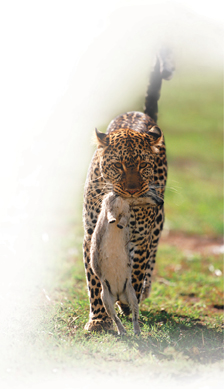Heterotrophs and Autotrophs
 What happens during the process of photosynthesis?
What happens during the process of photosynthesis?
Cells are not “born” with a supply of ATP—they must somehow produce it. So, where do living things get the energy they use to produce ATP? The simple answer is that it comes from the chemical compounds that we call food. Organisms that obtain food by consuming other living things are known as heterotrophs. Some heterotrophs get their food by eating plants such as grasses. Other heterotrophs, such as the leopard in Figure 8–3, obtain food from plants indirectly by feeding on plant-eating animals. Still other heterotrophs—mushrooms, for example—obtain food by absorbing nutrients from decomposing organisms in the environment.
Originally, however, the energy in nearly all food molecules comes from the sun. Plants, algae, and some bacteria are able to use light energy from the sun to produce food. Organisms that make their own food are called autotrophs. Ultimately, nearly all life on Earth, including ourselves, depends on the ability of autotrophs to capture the energy of sunlight and store it in the molecules that make up food. The process by which autotrophs use the energy of sunlight to produce high-energy carbohydrates—sugars and starches—that can be used as food is known as photosynthesis. Photosynthesis comes from the Greek words photo, meaning “light,” and synthesis, meaning “putting together.” Therefore, photosynthesis means “using light to put something together.”  In the process of photosynthesis, plants convert the energy of sunlight into chemical energy stored in the bonds of carbohydrates. In the rest of this chapter, you will learn how this process works.
In the process of photosynthesis, plants convert the energy of sunlight into chemical energy stored in the bonds of carbohydrates. In the rest of this chapter, you will learn how this process works.
MYSTERY CLUE

Like all plants, the willow tree van Helmont planted was an autotroph. What might its ability to harness the sun's energy and store it in food have to do with the tree's gain in mass?

FIGURE 8–3 Autotrophs and Heterotrophs Grass, an autotroph, uses energy from the sun to produce food. African hares get their energy by eating grass. Leopards, in turn, get their energy by eating other organisms, like the hare.
8.1 Assessment

-
Review What is ATP and what is its role in the cell?
Explain How does the structure of ATP make it an ideal source of energy for the cell?
Use Analogies Explain how ADP and ATP are each like a battery. Which one is “partially charged” and which one is “fully charged?” Why?
-
Review What is the ultimate source of energy for plants?
Explain How do heterotrophs obtain energy? How is this different from how autotrophs obtain energy?
Infer Why are decomposers, such as mushrooms, considered heterotrophs and not autotrophs?
Apply the Big idea
Recall that energy flows—and that nutrients cycle—through the biosphere. How does the process of photosynthesis impact both the flow of energy and the cycling of nutrients? You may wish to refer to Chapter 3 to help you answer this question.

Table of Contents
- Formulas and Equations
- Applying Formulas and Equations
- Mean, Median, and Mode
- Estimation
- Using Measurements in Calculations
- Effects of Measurement Errors
- Accuracy
- Precision
- Comparing Accuracy and Precision
- Significant Figures
- Calculating With Significant Figures
- Scientific Notation
- Calculating With Scientific Notation
- Dimensional Analysis
- Applying Dimensional Analysis




